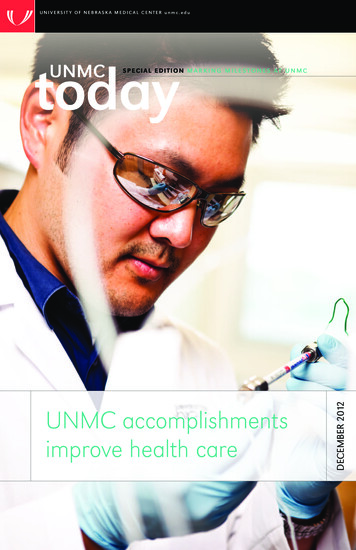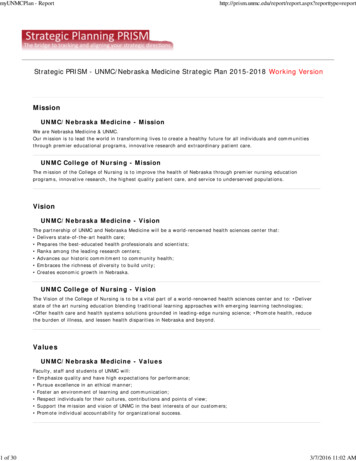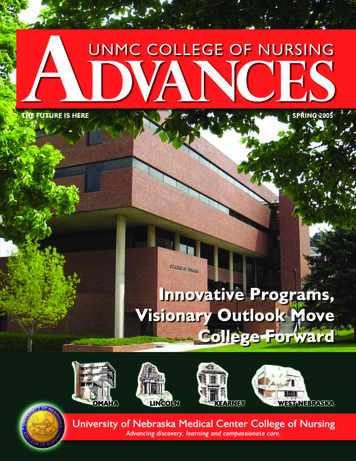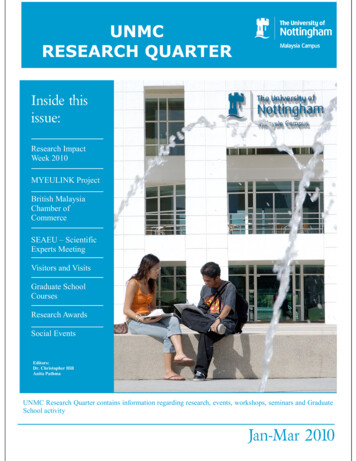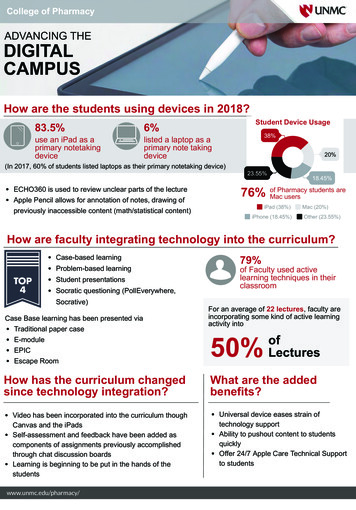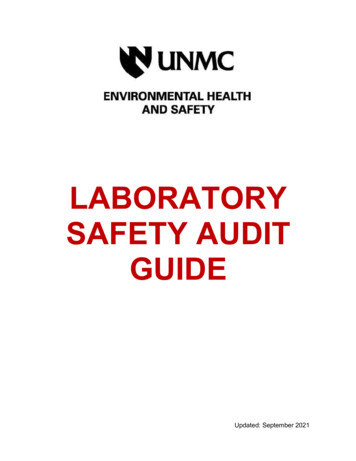
Transcription
LABORATORYSAFETY AUDITGUIDEUpdated: September 2021
Mission StatementThe mission of UNMC Environmental Health and Safety is to foster a culture of absolute safetyfor our students, faculty, staff, patients and visitors and to minimize environmental andregulatory risks to UNMC and Nebraska Medicine.We will realize this mission by adhering to our Values.ValuesIntegrity: Our department will be comprised of individuals committed to our mission andvalues. We will be accessible, professional, and courteous. We will have no fear in our pursuitof excellence and aim to be a trusted resource to the UNMC and Nebraska Medicinecommunity.Commitment: We are committed to provide expert guidance and timely service to make surethat UNMC and Nebraska Medicine are in compliance with the regulatory requirements forwhich we are responsible.Collaboration: We will grow as one Department, collaborating and working together to findinnovative solutions to any problem. We will emphasize open communication and focus onpartnering rather than policing to develop understanding and accountability for all.Excellence: We strive to go beyond compliance to be a preeminent EHS department and willwork to achieve exceptional results. We will diligently assess safety risks and develop policies,procedures, and innovative training and audit programs to keep these risks to the absoluteminimum.Empowerment: We will do our part to create an atmosphere that is culturally sensitive,diverse and inclusive which eliminates negative conditions impacting personal well-being. Wewill do this by developing policies and procedures in partnership with our customers, tailoredto our unique needs. This will empower faculty, staff and students to understand regulatorycompliance while maintaining academic freedom.
IntroductionAll laboratories are audited on an annual basis by the UNMC Environmental Health and SafetyOffice to ensure compliance with federal, state and university requirements. Inspections mayalso be periodically unannounced as they relate to a reported incident or when potentialunsafe laboratory practices are reported.If you have any questions regarding lab audits, or need to report any unsafe lab practicesplease contact the EHS Office at (402) 559-6356.As we all play an important role in research on campus, it is required that each lab beinspected according to policy. Based on the research being conducted in your lab, you aresubject to various lab audits/inspections at any time.The purpose of annual lab audits is to ensure all labs are following the appropriate lab safetypolicies and procedures within their research labs. Lab safety audits are conducted on anannual basis and scheduled through the Environmental, Health and Safety Office. Each labwill be contacted to schedule their annual audit.This audit covers the general practices of lab safety to meet OSHA requirements, as well asthe chemical safety audit of each lab to meet EPA requirements. The EPA RCRA ComplianceAudit program has evolved from the efforts of the Associate General Counsel and Director ofInstitutional Compliance for the University of Nebraska. The primary objective of the EPARCRA Compliance Audit is to provide EPA regulatory guidance to UNMC personnel, and hasbeen designed to accomplish the following goals:1. Ensure that all labs/chemical use areas are in compliance with EPA RCRA and OSHAregulations.2. Visit labs handling materials in order to gather information on the generation of hazardouswaste and subsequent disposal.3. To promote waste minimization and pollution prevention.4. Help UNMC personnel become familiar with EPA and OSHA regulatory complianceinspection interviews.The laboratory audit process at UNMC should be viewed as a positive management toolwhich provides the user and UNMC with an opportunity to assess environmental impacts andcorrect any potential problems prior to a regulatory inspection.
Laboratory Safety Audit CategoriesStandards and ExplanationsThis information is a supplement of standards and explanations to the audit items organizedby category on the laboratory safety audit checklist. The explanations provided are supportedby government and/or state regulations or are considered to be best practices by accreditedand respected sources.The primary purpose for annual laboratory safety audits is to ensure all laboratory principalinvestigators, staff, and students are conducting research safely and in accordance with theEPA and OSHA regulations applicable to the research laboratories.Please reference the UNMC Laboratory Safety Manual for additional information or contactthe Environmental Health & Safety (EHS) Office at 559-6356 or via email atunmcehs@unmc.edu.
Laboratory Safety Training1. Are all lab personnel, students, and working visitors trained on experiments and/or procedures that arebeing performed in the laboratory?While working in a research laboratory you will likely use instruments, materials and reagents that have thepotential to harm you, your co-workers and the environment. Consequently, it is important to spend time at thebeginning of your project to learn the safety standards of your discipline and workplace to ensure everyone’sgood health and safety. Effective training is critical to creating a safe environment and for the prevention oflaboratory incidents. You are required to document all training that is provided to personnel, students, andvisitors working in the laboratory. Laboratory Safety Training Record is available for laboratories to use anddocument lab-specific training requirements.Based upon the nature of the research work you will be doing, you may also be required to complete additionaltraining. Additional training is required for individuals that work with radioactivity, biohazard agents, researchanimals, and shipping dangerous goods.Reference: Section 5(a)(1) of the Occupational Safety and Health Act of 1970 (OSH Act), the General DutyClauseChemical Safety1.Have all individuals working in the lab been educated about the chemical hazards present within the labspace(s)?This includes hazards associated with equipment, stored energy, pressure vessels, hazardous chemicalreactions, shock sensitive substances, flammable/explosives, etc. All lab personnel must be aware of thehazards present and take the necessary steps to minimize or eliminate them. All employees/students inlaboratories must know what personal protective and safety equipment is available, when it is required, how touse it, when it is not safe to use and how to dispose of it. All laboratory safety training must be documented.Reference: The Occupational Exposure to Hazardous Chemicals in Laboratories standard (29 CFR 1910.1450)2.Has a risk hazard assessment been conducted for all chemicals, substances and processes that pose aphysical risk and/or health hazard?This may include chemicals that are flammable, air or water reactive, explosive, corrosive, toxic, etc. Risk hazardassessments should take into consideration ways to minimize or eliminate exposures to the physical and healthhazards through the use of engineering controls, barriers, substitution and/or personal protective equipment.This is also important so lab personnel know which chemical spills they can safely clean and which they needto call for assistance. Risk assessments must be documented and kept on file within the laboratory. Duringsafety audits, EHS staff may ask to see the documentation of risk assessment records.References: Laboratory Standard List for Particularly Hazardous Substances (PHS)PHS Assessment Form3.Are Safety Data Sheets (SDS) readily accessible to lab personnel for ALL chemicals/substances presentin the lab space(s)?Individuals must review SDS (formerly known as MSDS) information prior to working with any chemicals orsubstances. Appropriate PPE must be used as listed on the SDS. Ref:References: UNMC MSDS Online and OSHA 29 CFR 1910.1200(g)4.Are chemicals, including chemical waste, properly labeled and stored by hazardous class andcompatibility?Please reference the Hazardous Materials Fact Sheet, Chemical Storage, for information on storing ofchemicals. Flasks and/or media collections containers must be clearly labeled to indicate their contents so thoseresponding to spills will know what has spilled. Chemical collection containers must all be labeled with the word“waste” and the full chemical name(s). Do not use abbreviations of chemical names. Please reference ChemicalLabeling for additional information, and label templates that area available for you to use.
Once a collection container is full or has not been added to recently, the container must be tagged with a greenchemical collection tag for EHS to pick up and properly dispose of the chemical waste. Please reference theHazardous Materials Fact Sheet, Chemical Disposal, for additional information.Reference: EPA 40 CFR, 265.170-177, Subpart I—Use and Management of ContainersUNMC Chemical Labeling5.Are flammable chemicals, including chemical waste, being stored in an approved storage room orflammable liquids cabinet?Proper chemical storage is a requirement for any lab using hazardous materials. Chemicals shall be organizedby compatibility, clearly labeled with full chemical name (no abbreviations) and in good condition. (For example,it is dangerous to store acids with bases and/or flammables with corrosives). Solids are stored above and liquidsbelow. Oxidizers are not stored with organics. Flammable liquids are stored in a UL/FM approved flammableliquids cabinet, with a door that is latched shut. A one day "working" supply of flammables is all that is allowedto be kept outside of an approved storage room (ASR) or flammable liquids cabinet (FLC). Chemical wastecontainers must also be stored at or near the point of generation. Chemicals shall not be stored in a fume hoodor biosafety cabinet.Reference: NFPA 30, Flammable and Combustible Liquids Code6.Are all chemical waste containers closed, labeled appropriately, and stored in secondary containment?Please reference the Hazardous Materials Fact Sheet, Chemical Storage, for information on storing ofchemicals. Please reference the Hazardous Materials Fact Sheet, Chemical Waste Collection ContainerStorage, for information on storing of chemical waste containers.Reference: EPA 40 CFR, 265.1757.Is the lab properly disposing of chemical waste and all other EPA regulated items?Chemical waste must be properly disposed. Please reference the Hazardous Materials Fact Sheet, ChemicalDisposal, for additional information on how to submit this item for pick-up and disposal by EHS. For questionsrelated to EPA regulated items, please contact EHS at (402) 559-6356.Other EPA regulated items (i.e. aerosol cans, batteries, lead autoclave tape, and hand sanitizer) must also betagged with the green chemical collection tag and picked up by EHS staff.Certain chemicals can be safely disposed to the sanitary sewer. Please reference Hazardous Materials FactSheet, Sanitary Sewer Disposal, for additional information. This document will provide you with guidance onwhat can and cannot be disposed of through the sanitary sewer (sink).8.Is the lab properly disposing of empty chemical containers, including p-listed chemicals?Before disposing of empty chemical containers, labs must ensure it is not an item that is EPA regulated. Pleasereference the Hazardous Materials Fact Sheet, Empty Chemical Container Disposal, for additional information.9.Does the lab have mercury thermometers?Mercury affects the central nervous system and with prolonged exposure, can cause brain damage. It isrecommended that all labs replace mercury thermometers with alcohol thermometers. Elemental mercuryspills account for approximately 80% of the spills in which EHS staff respond to on campus. Elementalmercury is somewhat volatile and is readily absorbed via the respiratory tract and through the skin. It isrecommended that all labs replace mercury thermometers with alcohol thermometers. Mercury but bedisposed of through EHS.10. Has the lab submitted an updated chemical inventory to EHS within the last year?Information on submitting chemical inventories can be found online al-inventories.html11. Does the lab ship hazardous materials or dangerous goods? (i.e. biological agents, patient/animalspecimens, dry ice, chemicals)?All employees who ship hazardous materials or dangerous goods, which includes dry ice, Category AInfectious Substances affecting humans and/or animals, Category B Infectious Substances (biologicalsubstances), patient specimens (except human or animal specimens) and cultures, shall follow regulatoryrequirements for the applicable mode of transportation (e.g., air, ground).The shipment of hazardous materials or dangerous goods is a serious matter that requires UNMC compliancewith regulatory requirements. Employees shall meet the initial and recurrent training requirements prior to
signing a shipper's declaration or authorizing a hazardous material or dangerous goods package not requiringa shipper's declaration.Reference: Hazardous Material/Dangerous Goods Shipping Plan; DOT Title 49 CFR12. Does the lab ship items out of the country?This includes testing kits, chemicals, radioactive material, equipment, hardware and materials includingbiological maters, technical information or data and/or software/code.Reference: Export ControlEmergency Procedures1.Are laboratory personnel aware that they are to report all needle sticks and cuts via the OUCH Pager:402-888-6824?If laboratory personnel sustain a needle stick or cut, they must call the Employee Health 24/7 OUCH Pager at(402) 888-OUCH (6824). You will need to have your Principal Investigator’s contact information and it isextremely important to know what you have been exposed to prior to contacting the OUCH pager. This allowsthe individual receiving the call to provide proper guidance on how to treat the medical emergency. Exposureswith non-serious injuries, call the OUCH pager at (402) 888-OUCH (6824) for post exposure medical guidanceon exposures that occur on campus including needle stickers, biological, animal, etc.For all radioactive material and chemical exposures, please contact Campus Security at (402) 559-5555. Inthe event that you have an exposure with serious injuries, contact Campus Security at (402) 559-5555 or go tothe Emergency Department on campus.2.Are laboratory personnel aware of the Emergency Preparedness Guide, which includes the chemicalspill procedures?The Emergency preparedness guides are posted in all UNMC buildings near elevator lobbies and stairtower/exits. The guide is also available online: UNMC Emergency Preparedness Guide. These guides provideinformation on what to do in the event of an emergency.Report all spills to UNMC Campus Security at (402) 559-5555. Chemical spills can and do occur despite ourbest intentions. Depending on the chemical properties and quantity of the spilled chemical it can createpotentially dangerous situations. Therefore, it is important that UNMC personnel are prepared for chemicalspills.Reference: 42 CFR 483.73 Emergency Preparedness3.Does the laboratory have a current (2020) laboratory safety poster present and have all laboratorypersonnel reviewed the information?This poster is to comply with the fire marshal's requirement that each lab has a laboratory safety poster, inlanguages understood by lab staff. The laboratory's department is responsible for working with EHS on gettingthe poster translated, if necessary.If you need assistance with your laboratory safety poster or to request a laboratory safety poster, pleasecontact Kelly Johnson at (402) 559-9913, ka.johnson@unmc.edu. You may also download and print a posteron 11”x17” paper: UNMC Laboratory Safety Poster.Listed below are some of the items included on the Laboratory Safety Poster. All laboratory personnel mustreview this information and know the location for all items listed on this poster.Laboratory Emergency Equipment: Safety ShowersThe OSHA requirements for emergency eyewashes and showers, specify that "where the eyes orbody of any person may be exposed to injurious corrosive materials, as well as additional substancesand compounds that have the capability of producing adverse effects on the health and safety ofhumans suitable facilities for quick drenching or flushing of the eyes and body shall be provided within
the work area for immediate emergency use. Workers in laboratories and other places wherebiological or chemical agents are used must have fast access to emergency flushing areas. Theseareas are necessary for the immediate first aid of chemical splashes or other incidents. In the event ofcontact with a chemical or substance, emergency showers should be used for the immediate removalof chemical splashes and spills.Laboratory personnel must know the location of the nearest safety shower. Safety Showers must bekept free from obstructions, at ALL times.Reference: OSHA 29CFR 1910.151(c), ANSI [Z] 358.1-2004) Eyewash StationsAn emergency eyewash station provides a means to remove chemical contamination from the eyesand/or face. Eyewash stations within laboratory rooms must be tested and recorded weekly bylaboratory personnel to ensure water flow and quality. Eyewash/Drench Hose Weekly Inspection LogForm This helps clean out any rust, scale deposits, or bacteria that may accumulate. Laboratorypersonnel must know the location of the nearest eyewash station. Eyewash stations must be kept freefrom obstructions, at ALL times.References:Laboratory Safety Manual, Section 4 (Laboratory Emergency Equipment)OSHA 29CFR 1910.151(c), ANSI [Z]358.1-2004 Personal Protective Equipment (PPE)Personal protective equipment is protective gear needed to keep workers safe while performing theirjobs. It is a general term used to describe anything you can wear and/or use in order to protectyourself when working with chemical or biological hazards.It is important that PPE is selected based upon the hazard(s) to the worker, properly fitted and in somecases periodically refitted (e.g. respirators), conscientiously and properly worn, regularly maintainedand replaced in accordance with manufacturer’s specifications, properly removed and disposed of toavoid contamination of self, others or the environment.References: Laboratory Safety Manual, Section 5 (PPE)4. Fire alarm pull station, fire extinguisher and exit stair towerBe aware of your surroundings at all times, and know the location of the nearest fire extinguisher, firealarm pull station and the nearest exit stair tower. Knowing the location of each, can expediteresponse and minimize the risk of injury and/or death. If you need assistance locating the fire alarmpull station nearest to your area, please contact EHS at (402) 559-6356. Muster pointA muster point is the place everyone must go in an emergency to make sure no one is missing. Thosenot accounted for must be reported to the Security Officer in charge. Lab personnel should worktogether to determine a muster point location. Severe Weather Safe AreaBuilding evacuation plans are posted by stair tower exits and/or elevator lobbies in most buildings. Thebuilding evacuation plan will highlight the designated safe area for the building. Severe weather canhappen anytime, in any place. Severe weather includes hazardous conditions produced bythunderstorms, including damaging winds, tornadoes, large hail, flooding and flash flooding, and winterstorms associated with freezing rain, sleet, snow and strong winds.Does the lab have a chemical spill kit?Every laboratory must have a chemical spill kit present and stored near where chemicals are used. Forinformation on purchasing a chemical spill kit, please reference the Hazardous Material Fact Sheet, ChemicalSpill Kits. All laboratory personnel must know the location of the chemical spill kit within their laboratory.
References: EPA 40 CFR 112.7, OSHA 29 CFR 1910.120, OSHA 29 CFR 1910.225.Does laboratory personnel know how to report fires, chemical spills, exposures, and otheraccidents/incidents or near misses?Reporting fires must be done by pulling the fire alarm and dialing the Campus Emergency Number (402) 5595555. ALL fires must be reported (including those you have put out). The fire alarm alerts everyone in thebuilding that something is occurring. Everyone must follow the directions given over the fire alarm housepaging system and/or in person by Campus Security, Omaha Fire Department, or Omaha Police Department.All accidents/incidents or near misses must be reported by completing the Incident Report form. This willprovide complete and accurate documentation of the details related to an incident, ensure follow-up and allowtraining to be developed to prevent future occurrences. Please reference the UNMC Emergency PreparednessGuide.6.Are staff aware that they MUST evacuate the building if directed to do so and not re-enter until the "allclear" has been issued?An order to evacuate may be given during a fire, hazardous material spill/release or any other situation whichmay endanger the building occupants. Smoke and hot gases are toxic and lethal. The order to evacuate maycome in the form of a message played over the fire alarm system, an order from Security/police/fireman or theIncident Commander. It may be communicated over the fire alarm system, public address/paging system,emergency notification systems, or in person. No one is to re-enter the building/area until the fire departmenthas declared it to be safe and the "ALL CLEAR" has been given. Failure to follow directions to evacuate mayresult in disciplinary action or your arrest. Please reference the UNMC Emergency Preparedness Guide.General Safety1.Are food and drink present in the lab?The use of food and drink and/or the application of cosmetics, lip balm or contact lens are not allowed in anyareas including laboratories where chemical, biological or radioactive materials are used or stored. Thisprevents the accidental ingestion of harmful items if food were to become contaminated. Make sure to washhands before eating, drinking or applying cosmetics.References: No Food or Drink Poster; UNMC Food, Drinks, and Cosmetic Use in Laboratory Areas Policy#20102.Do all aisles within the laboratory space(s) have sufficient width of 36” for passing?The requirement for research laboratories on campus is a 36-inch clearance for aisle spaces. The fire marshalwill measure "clear and unobstructed" width by opening the doors and drawers to cabinets and taking themeasurement. The spaces between benches, cabinets and equipment must also be accessible for cleaning.Keep aisles and passageways clear and in good repair, with no obstruction across or in aisles that couldcreate a hazard.Reference. OSHA Standard Walking-Working Surfaces, 29 CFR 1910.22, NFPA 101-2015 36.2.5.53.Are any doors or corridors obstructed?No items shall be placed which block doors. No items shall be stored in corridors. Doors must be able to beopened at all times. Doors must also be able to close at all times, to prevent the spread of smoke, fire andfumes. Corridors must be kept clear to provide quick and safe access to exits in emergencies. Keep exits freefrom obstruction. Access to exits must remain clear of obstructions at all times. Exit routes must be free andunobstructed. No materials or equipment may be placed, either permanently or temporarily, within the exitroute.Reference: OSHA 29 CFR 1910.374.Are there any items placed on the corridor doors or vision panels (windows) on the doors?These doors are fire doors and nothing is to be placed on fire doors or vision panels in fire doors, as it mayimpede egress, and not allow inspection of the lab from the corridor.
5.Are any doors being held and/or propped open with a door stop or other object?Blocking or wedging doors open will allow the spread of smoke, fire and fumes to enter the corridor making itdifficult to evacuate in the event of a fire emergency.6.Is the appropriate dress code attire being worn within the lab?All laboratory personnel shall be dressed in a manner that does not impair safety. Open toed shoes are NOTallowed in the laboratory. Dressing appropriately prevents injury from hazardous substance spills and sharps.Long hair must be tied back. Avoid wearing loose clothing and dangling jewelry, as they can becomeentangled with equipment.7.Is Personal Protective Equipment (PPE) readily available (lab coats, gowns, gloves, face protection,etc.) for all lab personnel and are lab personnel trained to use the appropriate PPE?Personal protective equipment, commonly referred to as "PPE", is equipment worn to minimize exposure tohazards that cause serious workplace injuries and illnesses. These injuries and illnesses may result fromcontact with chemical, radiological, physical, electrical, mechanical, or other workplace hazards. Personalprotective equipment may include items such as knee length lab coats (buttoned to protect your clothing),gloves, safety glasses and shoes, earplugs or muffs, hard hats, respirators, or coveralls, vests and full bodysuits. Please reference the Laboratory PPE Selection Guide for additional information on types of PPE.The laboratory PI must provide appropriate PPE for each employee/student working in the laboratory andrecord the issuance of PPE for each individual. All lab personnel shall know what PPE is available, when it isrequired, how to use it, when it is not safe to use and how to dispose of items. PPE must be readily availableand used when necessary. It must also be checked before each use to see that it is in good condition. All PPEclothing and equipment must be of safe design and construction and must be maintained in a clean andreliable fashion. PPE Issuance and Training Record FormReferences: OSHA PPE Fact Sheet; OSHA Standard Personal Protective Equipment, 29 CFR 1910.132(a),8.Is appropriate eye protection readily available for the hazards (UV, lasers, chemicals, etc.) within thelaboratory and are all lab personnel trained to use the proper eye protection?It is important to always use safety eyewear that meets American National Standards Institute (ANSI) standardZ87.1. Safety eyewear that meets Z87 is tested and must pass stringent requirements for impact, distortion,light transmittance, and lens thickness, among others. The type of eye protection must match the hazard, andthere are definitely types more appropriate for certain hazards. Special hazards such as UVL, welding, or lasersrequire special safety eyewear.References: International Safety Equipment Association Eye & Face Protection, ANSI Z87.1,ANSI Z136.1-2014, OSHA 1910.1329.Is respiratory protection used in the lab?ALL respirator users must have a medical evaluation and be fit tested on an annual basis. This includes allNIOSH approved and disposable N-95 respirators. Respirator and/or Powered Air Purifying Respirator(PAPR) users must be trained in the proper care and use of the respirator/PAPR.The laboratory PI must provide respirators that are appropriate based on the hazards to which theiremployees/students are exposed and factors that affect respirator performance and reliability. The laboratoryPI must keep an up to date record of all employee/student respirator fit testing certifications. Contact EHS forassistance in selecting the appropriate respirator, or PAPR, for the task and/or if you have any questions aboutfit-testing and training.*Standard surgical/dust masks do not require fit-testing. If the surgical/dust mask reads NIOSH or N-95, thatis considered a respirator and you must be fit-tested accordingly.References: CDC: Respirator Trusted-Source Information; OSHA Respirator Protection eTool; OSHA 3079:Respiratory Protection; OSHA 29 CFR 1910.134
10. Are appropriate gloves being used and then removed prior to leaving the lab?Gloves must be compatible with the material being handled. When handling chemical, physical and/orbiological hazards that can enter the body through the skin, it is important to wear the proper protective gloves.In essence, certain gloves provide better protection than others. Microflex Chemical Resistance Glove GuideThe use of powdered latex gloves is prohibited on campus. UNMC Latex Sensitivity Policy 2003Gloves must be removed in the work area before leaving the lab and or touching door handles, elevatorbuttons, light switches, phones, etc. How to Remove Gloves Perform hand hygiene after removing gloves.Wash Your Hands This prevents contamination of surfaces with chemical or biologicals and exposing others.Carry potentially containment equipment or product in a secondary, leak-proof container. The container mustbe decontaminated after each use.References: OSHA 29 CFR 1910.13811. Are animals used in the laboratory? If yes, do all laboratory personnel have the approval of use,access to IACUC protocol, appropriate training, and animal contact clearance?All research, testing, and teaching projects involving the use of live vertebrate animals, and personnel, mustbe reviewed and approved by the IACUC (Institutional Animal Care and Use Committee). All individuals whowill work with or have contact with research animals, their housing equipment, bedding, waste products, etc.must be enrolled in the Occupational Health and Safety Program.For safety and health standards in laboratories, please reference OSHA Laboratory Safety Guidance:OSHA3404-11R 2011, 29 CFR 1910.1450.Laboratory Signage1.Does the laboratory sign posted outside of the laboratory, and/or shared space locations, reflectcurrent information?Laboratory signs are designed to provide information on the hazards present in the laboratory to serviceworkers and emergency personnel. Lab signs must be updated annually and/or when there are any labpersonnel, chemical or process changes. Lab signs must contain a primary and secondary contact, to includea phone number to be reached during business hours. The contact information is provi
This audit covers the general practices of lab safety to meet OSHA requirements, as well as the chemical safety audit of each lab to meet EPA requirements. The EPA RCRA Compliance Audit program has evolved from the efforts of the Associate General Counsel and Director of Institutional Compliance for the University of Nebraska.
